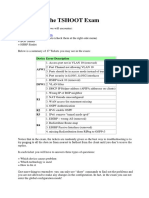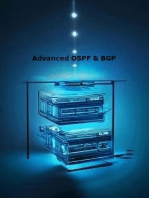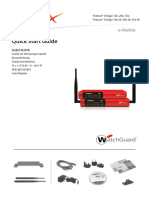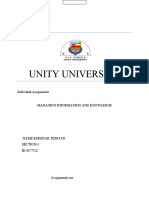300-135 Exam Dumps With PDF and VCE Download (61-End) PDF
300-135 Exam Dumps With PDF and VCE Download (61-End) PDF
Uploaded by
Elquia MadridCopyright:
Available Formats
300-135 Exam Dumps With PDF and VCE Download (61-End) PDF
300-135 Exam Dumps With PDF and VCE Download (61-End) PDF
Uploaded by
Elquia MadridOriginal Title
Copyright
Available Formats
Share this document
Did you find this document useful?
Is this content inappropriate?
Copyright:
Available Formats
300-135 Exam Dumps With PDF and VCE Download (61-End) PDF
300-135 Exam Dumps With PDF and VCE Download (61-End) PDF
Uploaded by
Elquia MadridCopyright:
Available Formats
Free VCE and PDF Exam Dumps from PassLeader
Vendor: Cisco
Exam Code: 300-135
Exam Name: Troubleshooting and Maintaining
Cisco IP Networks (TSHOOT v2.0)
Question 61 The End
Visit PassLeader and Download Full Version 300-135 Exam Dumps
QUESTION 61
The implementations group has been using the test bed to do a `proof-of-concept' that requires
both Client 1 and Client 2 to access the WEB Server at 209.65.200.241. After several changes to
the network addressing, routing scheme, DHCP services, NTP services, layer 2 connectivity, FHRP
services, and device security, a trouble ticket has been opened indicating that Client 1 cannot ping
the 209.65.200.241 address.
Use the supported commands to isolated the cause of this fault and answer the following questions.
What is the solution to the fault condition?
A. In Configuration mode, using the interface range Fa 1/0/1 - 2, then no switchport port- security
interface configuration commands.
Then in exec mode clear errdisable interface fa 1/01 - 2 vlan 10 command
B. In Configuration mode, using the interface range Fa 1/0/1 - 2, then no switchport port- security,
followed by shutdown, no shutdown interface configuration commands.
C. In Configuration mode, using the interface range Fa 1/0/1 - 2, then no switchport port- security
interface configuration commands.
D. In Configuration mode, using the interface range Fa 1/0/1 - 2, then no switchport port- security
interface configuration commands.
Then in exec mode clear errdisable interface fa 1/0/1, then clear errdisable interface fa 1/0/2
commands.
Answer: B
Explanation:
On ASW1, we need to remove port-security under interface fa1/0/1 & fa1/0/2.
http://www.cisco.com/en/US/tech/ABC389/ABC621/technologies_tech_note09186a00806c
d87b.shtml
Ticket 8 : Redistribution of EIGRP to OSPF
Topology Overview (Actual Troubleshooting lab design is for below network design)
- Client Should have IP 10.2.1.3
300-135 Exam Dumps
300-135 Exam Questions 300-135 PDF Dumps
http://www.passleader.com/300-135.html
300-135 VCE Dumps
Free VCE and PDF Exam Dumps from PassLeader
- EIGRP 100 is running between switch DSW1 & DSW2
- OSPF (Process ID 1) is running between R1, R2, R3, R4
- Network of OSPF is redistributed in EIGRP
- BGP 65001 is configured on R1 with Webserver cloud AS 65002
- HSRP is running between DSW1 & DSW2 Switches
The company has created the test bed shown in the layer 2 and layer 3 topology exhibits.
This network consists of four routers, two layer 3 switches and two layer 2 switches.
In the IPv4 layer 3 topology, R1, R2, R3, and R4 are running OSPF with an OSPF process number
1.
DSW1, DSW2 and R4 are running EIGRP with an AS of 10. Redistribution is enabled where
necessary.
R1 is running a BGP AS with a number of 65001. This AS has an eBGP connection to AS 65002
in the ISP's network. Because the company's address space is in the private range.
R1 is also providing NAT translations between the inside (10.1.0.0/16 & 10.2.0.0/16) networks and
outside (209.65.0.0/24) network.
ASW1 and ASW2 are layer 2 switches.
NTP is enabled on all devices with 209.65.200.226 serving as the master clock source.
The client workstations receive their IP address and default gateway via R4's DHCP server.
The default gateway address of 10.2.1.254 is the IP address of HSRP group 10 which is running
on DSW1 and DSW2.
In the IPv6 layer 3 topology R1, R2, and R3 are running OSPFv3 with an OSPF process number
6.
DSW1, DSW2 and R4 are running RIPng process name RIP_ZONE.
The two IPv6 routing domains, OSPF 6 and RIPng are connected via GRE tunnel running over the
underlying IPv4 OSPF domain. Redistrution is enabled where necessary.
Recently the implementation group has been using the test bed to do a `proof-of-concept' on
several implementations. This involved changing the configuration on one or more of the devices.
You will be presented with a series of trouble tickets related to issues introduced during these
configurations.
Note: Although trouble tickets have many similar fault indications, each ticket has its own issue and
solution.
Each ticket has 3 sub questions that need to be answered & topology remains same.
Question-1 Fault is found on which device,
Question-2 Fault condition is related to,
Question-3 What exact problem is seen & what needs to be done for solution
Client is unable to ping IP 209.65.200.241
Solution:
Steps need to follow as below:
- When we check on client 1 & Client 2 desktop we are not receiving DHCP address from R4
ipconfig ----- Client will be receiving IP address 10.2.1.3
- IP 10.2.1.3 will be able to ping from R4 , but cannot ping from R3, R2, R1
- This clearly shows problem at R4 since EIGRP is between DSW1, DSW2 & R4 and OSPF protocol
is running between R4, R3, R2, R1 so routes from R4 are not propagated to R3, R2, R1
- Since R4 is able to ping 10.2.1.3 it means that routes are received in EIGRP & same needs to be
advertised in OSPF to ping from R3, R2, R1.
- Need to check the routes are being advertised properly or not in OSPF & EIGRP vice-versa.
300-135 Exam Dumps
300-135 Exam Questions 300-135 PDF Dumps
http://www.passleader.com/300-135.html
300-135 VCE Dumps
Free VCE and PDF Exam Dumps from PassLeader
- From above snap shot it clearly indicates that redistribution done in EIGRP is having problem &
by default all routes are denied from ospf to EIGRP... so need to change route-map name.
- Change required: On R4, in redistribution of EIGRP routing protocol, we need to change name of
route-map to resolve the issue...
QUESTION 62
The implementations group has been using the test bed to do a `proof-of-concept' that requires
both Client 1 and Client 2 to access the WEB Server at 209.65.200.241. After several changes to
the network addressing, routing scheme, DHCP services,
NTP services, layer 2 connectivity, FHRP services, and device security, a trouble ticket has been
opened indicating that Client 1 cannot ping the 209.65.200.241 address.
Use the supported commands to isolated the cause of this fault and answer the following questions.
On which device is the fault condition located?
A.
B.
C.
D.
E.
R1
R2
R3
R4
DSW1
300-135 Exam Dumps
300-135 Exam Questions 300-135 PDF Dumps
http://www.passleader.com/300-135.html
300-135 VCE Dumps
Free VCE and PDF Exam Dumps from PassLeader
F. DSW2
G. ASW1
H. ASW2
Answer: D
Explanation:
On R4, in the redistribution of EIGRP routing protocol, we need to change name of route- map to
resolve the issue. It references route-map OSPF_to_EIGRP but the actual route map is called
OSPF->EIGRP.
QUESTION 63
The implementations group has been using the test bed to do a `proof-of-concept' that requires
both Client 1 and Client 2 to access the WEB Server at 209.65.200.241. After several changes to
the network addressing, routing scheme, DHCP services, NTP services, layer 2 connectivity, FHRP
services, and device security, a trouble ticket has been opened indicating that Client 1 cannot ping
the 209.65.200.241 address.
Use the supported commands to isolated the cause of this fault and answer the following questions.
The fault condition is related to which technology?
A.
B.
C.
D.
E.
F.
G.
H.
I.
NTP
IP DHCP Server
IPv4 OSPF Routing
IPv4 EIGRP Routing
IPv4 Route Redistribution
IPv6 RIP Routing
IPv6 OSPF Routing
IPv4 and IPv6 Interoperability
IPv4 layer 3 security
Answer: E
Explanation:
On R4, in the redistribution of EIGRP routing protocol, we need to change name of route- map to
resolve the issue. It references route-map OSPF_to_EIGRP but the actual route map is called
OSPF->EIGRP.
QUESTION 64
The implementations group has been using the test bed to do a `proof-of-concept' that requires
both Client 1 and Client 2 to access the WEB Server at 209.65.200.241. After several changes to
the network addressing, routing scheme, DHCP services, NTP services, layer 2 connectivity, FHRP
services, and device security, a trouble ticket has been opened indicating that Client 1 cannot ping
the 209.65.200.241 address.
Use the supported commands to isolated the cause of this fault and answer the following questions.
Which is the solution to the fault condition?
A. Under the EIGRP process, delete the redistribute ospf 1 route-map OSPF_ to_ EIGRP command
and enter the redistribute ospf 1 route-map OSPF - > EIGRP command.
B. Under the EIGRP process, delete the redistribute ospf 1 route-map OSPF_ to_ EIGRP command
and enter the redistribute ospf 6 metric route-map OSPF - > EIGRP command.
C. Under the OSPF process, delete the redistribute eigrp10 subnets route-map EIGPR - >OSPF
command and enter the redistribute eigrp10 subnets route-map OSPF - > EIGRP command.
D. Under the OSPF process, delete the redistribute eigrp10 subnets route-map EIGPR - >OSPF
command and enter the redistribute eigrp10 subnets route-map EIGPR - > OSPF command.
300-135 Exam Dumps
300-135 Exam Questions 300-135 PDF Dumps
http://www.passleader.com/300-135.html
300-135 VCE Dumps
Free VCE and PDF Exam Dumps from PassLeader
E. Under the EIGRP process, delete the redistribute ospf 1 route-map OSPF _to_ EIGRP command
and enter redistribute ospf 1 metric 100000 100 100 1 15000 route_ map OSPF _to _EIGRP
command
Answer: A
Explanation:
On R4, in the redistribution of EIGRP routing protocol, we need to change name of route- map to
resolve the issue. It references route-map OSPF_to_EIGRP but the actual route map is called
OSPF->EIGRP.
Ticket 9 : EIGRP AS number
Topology Overview (Actual Troubleshooting lab design is for below network design)
- Client Should have IP 10.2.1.3
- EIGRP 100 is running between switch DSW1 & DSW2
- OSPF (Process ID 1) is running between R1, R2, R3, R4
- Network of OSPF is redistributed in EIGRP
- BGP 65001 is configured on R1 with Webserver cloud AS 65002
- HSRP is running between DSW1 & DSW2 Switches
The company has created the test bed shown in the layer 2 and layer 3 topology exhibits.
This network consists of four routers, two layer 3 switches and two layer 2 switches.
In the IPv4 layer 3 topology, R1, R2, R3, and R4 are running OSPF with an OSPF process number
1.
DSW1, DSW2 and R4 are running EIGRP with an AS of 10. Redistribution is enabled where
necessary.
R1 is running a BGP AS with a number of 65001. This AS has an eBGP connection to AS 65002
in the ISP's network. Because the company's address space is in the private range.
R1 is also providing NAT translations between the inside (10.1.0.0/16 & 10.2.0.0/16) networks and
outside (209.65.0.0/24) network.
ASW1 and ASW2 are layer 2 switches.
NTP is enabled on all devices with 209.65.200.226 serving as the master clock source.
The client workstations receive their IP address and default gateway via R4's DHCP server.
The default gateway address of 10.2.1.254 is the IP address of HSRP group 10 which is running
on DSW1 and DSW2.
In the IPv6 layer 3 topology R1, R2, and R3 are running OSPFv3 with an OSPF process number
6.
DSW1, DSW2 and R4 are running RIPng process name RIP_ZONE.
The two IPv6 routing domains, OSPF 6 and RIPng are connected via GRE tunnel running over the
underlying IPv4 OSPF domain. Redistrution is enabled where necessary.
Recently the implementation group has been using the test bed to do a `proof-of-concept' on
several implementations. This involved changing the configuration on one or more of the devices.
You will be presented with a series of trouble tickets related to issues introduced during these
configurations.
Note: Although trouble tickets have many similar fault indications, each ticket has its own issue and
solution.
Each ticket has 3 sub questions that need to be answered & topology remains same.
Question-1 Fault is found on which device,
Question-2 Fault condition is related to,
Question-3 What exact problem is seen & what needs to be done for solution
Client is unable to ping IP 209.65.200.241
Solution:
Steps need to follow as below:
- When we check on client 1 & Client 2 desktop we are not receiving DHCP address from R4
ipconfig ----- Client will be receiving IP address 10.2.1.3
- From Client PC we can ping 10.2.1.254
- But IP 10.2.1.3 is not able to ping from R4, R3, R2, R1
300-135 Exam Dumps
300-135 Exam Questions 300-135 PDF Dumps
http://www.passleader.com/300-135.html
300-135 VCE Dumps
Free VCE and PDF Exam Dumps from PassLeader
- This clearly shows problem at R4 Kindly check routes in EIGRP there are no routes of eigrp.
- Check the neighborship of EIGRP on R4; there are no neighbor seen from DSW1 & DSW2 check
the running config of EIGRP protocol it shows EIGRP AS 1 process.... Now check on DSW1 &
DSW2
On DSW1 only one Eigrp neighbour is there with DSW2 but its not with R4...
- From above snapshot & since R4 has EIGRP AS number 1 due to which neighbour is not
happening.
- Change required: On R4, IPV4 EIGRP Routing, need to change the EIGRP AS number from 1 to
10 since DSW1 & DSW2 is having EIGRP AS number 10
QUESTION 65
The implementations group has been using the test bed to do a `proof-of-concept' that requires
both Client 1 and Client 2 to access the WEB Server at 209.65.200.241. After several changes to
the network addressing, routing scheme, DHCP services, NTP services, layer 2 connectivity, FHRP
services, and device security, a trouble ticket has been opened indicating that Client 1 cannot ping
the 209.65.200.241 address.
Use the supported commands to isolated the cause of this fault and answer the following questions.
On which device is the fault condition located?
A.
B.
C.
D.
E.
F.
G.
H.
R1
R2
R3
R4
DSW1
DSW2
ASW1
ASW2
Answer:
Visit PassLeader and Download Full Version 300-135 Exam Dumps
300-135 Exam Dumps
300-135 Exam Questions 300-135 PDF Dumps
http://www.passleader.com/300-135.html
300-135 VCE Dumps
You might also like
- Cloud and Virtual Data Storage Networking - Your Journey To Efficient and Effective Information Services PDFDocument380 pagesCloud and Virtual Data Storage Networking - Your Journey To Efficient and Effective Information Services PDFcormeurs100% (1)
- 300-410 ENARSI - New Q AddedDocument43 pages300-410 ENARSI - New Q AddedRakesh KumarNo ratings yet
- Blockchain Unconfirmed Transaction Hack Scriptdocx PDF FreeDocument4 pagesBlockchain Unconfirmed Transaction Hack Scriptdocx PDF FreeSathish SizzyNo ratings yet
- Industrial Cyber Security Certification - GICSP - GIAC CertificationsDocument4 pagesIndustrial Cyber Security Certification - GICSP - GIAC Certificationsshyam_krishnan_1650% (2)
- Cisco 300-410 v2022-04-01 q84Document64 pagesCisco 300-410 v2022-04-01 q84beloow beloowNo ratings yet
- Pass4sure 300-135: Troubleshooting and Maintaining Cisco IP Networks (TSHOOT)Document11 pagesPass4sure 300-135: Troubleshooting and Maintaining Cisco IP Networks (TSHOOT)alizamaxNo ratings yet
- New Flydumps 300-135 Dumps PDF - Troubleshooting and Maintaining Cisco IP Networks (TSHOOT v2.0)Document5 pagesNew Flydumps 300-135 Dumps PDF - Troubleshooting and Maintaining Cisco IP Networks (TSHOOT v2.0)Evelyn R. KellyNo ratings yet
- Implementing Cisco IP Switched Networks (SWITCH v2.0)Document12 pagesImplementing Cisco IP Switched Networks (SWITCH v2.0)alizamaxNo ratings yet
- Cisco 300-410 v2021-07-10 q64Document38 pagesCisco 300-410 v2021-07-10 q64Anna DangNo ratings yet
- Testpdf 認證大師Document36 pagesTestpdf 認證大師specific4xNo ratings yet
- 300-410 15 Q&AsDocument15 pages300-410 15 Q&AsmshafiNo ratings yet
- Cisco 300-410 - Vmar-2023 by - Any189qDocument142 pagesCisco 300-410 - Vmar-2023 by - Any189qmasemolakelvinNo ratings yet
- Worktut 300-135 v2015-07-21 by Emmy 68qDocument205 pagesWorktut 300-135 v2015-07-21 by Emmy 68qPaulo DembiNo ratings yet
- PassLeader 300-101 Exam Dumps (61-90)Document15 pagesPassLeader 300-101 Exam Dumps (61-90)raczeklNo ratings yet
- ENARSI Training New ENARSI QuestionsDocument11 pagesENARSI Training New ENARSI QuestionsSurya Roganda Setiawan SitungkirNo ratings yet
- Juniper Test-Inside jn0-348 Exam Dumps 2020-Jan-15 by Hiram 73q VceDocument11 pagesJuniper Test-Inside jn0-348 Exam Dumps 2020-Jan-15 by Hiram 73q Vcebaolinh291187No ratings yet
- Tshoot CCNPDocument19 pagesTshoot CCNPJamez STNo ratings yet
- PassLeader Juniper JNCIP SP JN0 661 Exam Dumps Braindumps PDF VCEDocument77 pagesPassLeader Juniper JNCIP SP JN0 661 Exam Dumps Braindumps PDF VCEZivah ShipenaNo ratings yet
- PassLeader 300-101 Exam Dumps (121-End)Document5 pagesPassLeader 300-101 Exam Dumps (121-End)raczeklNo ratings yet
- CCNP 300-410 October 2020Document51 pagesCCNP 300-410 October 2020Sang Nguyen NgocNo ratings yet
- (2020-August-New) Braindump2go 300-410 PDF Dumps and 300-410 VCE Dumps (Q61-Q71)Document6 pages(2020-August-New) Braindump2go 300-410 PDF Dumps and 300-410 VCE Dumps (Q61-Q71)NicoNo ratings yet
- Tshoot 300-315Document19 pagesTshoot 300-315Paulo DembiNo ratings yet
- Cisco.Test-king.640-875.v2015-04-01.by.Flossie.144qDocument170 pagesCisco.Test-king.640-875.v2015-04-01.by.Flossie.144qjose rivasNo ratings yet
- Cisco 300-135. Exam Dumps: Page 1 / 7Document7 pagesCisco 300-135. Exam Dumps: Page 1 / 7lbcp328No ratings yet
- 300-420-ENSLD Designing Cisco Enterprise Networks Exam QuestionsDocument124 pages300-420-ENSLD Designing Cisco Enterprise Networks Exam Questionsahmad manchNo ratings yet
- A Guide For The TSHOOT Exam: 2 Simlet Multiple Choice QuestionsDocument22 pagesA Guide For The TSHOOT Exam: 2 Simlet Multiple Choice QuestionsYogesh KhollamNo ratings yet
- 200 301 DemoDocument17 pages200 301 DemoCisco Exam Dumps articleNo ratings yet
- (Nov-2020-Updated) PassLeader 2020 CCNP 300-410 ENARSI Exam DumpsDocument7 pages(Nov-2020-Updated) PassLeader 2020 CCNP 300-410 ENARSI Exam DumpsSang Nguyen NgocNo ratings yet
- Cisco Tshoot 2019 July DumpsDocument93 pagesCisco Tshoot 2019 July DumpsajdCruiseNo ratings yet
- 20.1.2 Lab Configure Secure DMVPN TunnelsDocument11 pages20.1.2 Lab Configure Secure DMVPN Tunnelshassa nestor theraNo ratings yet
- Cisco Exam - Troubleshooting and Maintaining Cisco IP Networks (TSHOOT v2.0)Document5 pagesCisco Exam - Troubleshooting and Maintaining Cisco IP Networks (TSHOOT v2.0)Joshua J. JaimesNo ratings yet
- Practice Test: Cisco 642-691Document84 pagesPractice Test: Cisco 642-691luckyhceNo ratings yet
- Practice Test: Cisco 642-832Document249 pagesPractice Test: Cisco 642-832Bill HONo ratings yet
- (Dec-2021-Updated) PassLeader 2020 CCIE-CCNP 350-501 SPCOR Exam DumpsDocument7 pages(Dec-2021-Updated) PassLeader 2020 CCIE-CCNP 350-501 SPCOR Exam DumpsCho Lin MaungNo ratings yet
- CCNP Ccie 300 410 Enarsi DigitalTUT New-Q PDFDocument14 pagesCCNP Ccie 300 410 Enarsi DigitalTUT New-Q PDFCristihan RenteriaNo ratings yet
- (Jan-2019) New PassLeader 300-101 Exam DumpsDocument4 pages(Jan-2019) New PassLeader 300-101 Exam DumpsMunteanu AlexandruNo ratings yet
- Cisco: Troubleshooting and Maintaining Cisco IP Networks (Tshoot)Document5 pagesCisco: Troubleshooting and Maintaining Cisco IP Networks (Tshoot)etseNo ratings yet
- CCNP 300 410 ENARSI NetworkTUT 26 5 2021Document104 pagesCCNP 300 410 ENARSI NetworkTUT 26 5 2021Olga BradyNo ratings yet
- Lab EIGRP 2Document15 pagesLab EIGRP 2Danny Ricce EnriqueNo ratings yet
- Gre Lab 2Document20 pagesGre Lab 2jkararrigasNo ratings yet
- 642 832Document323 pages642 832hasratraNo ratings yet
- Lab EIGRP 4Document13 pagesLab EIGRP 4Danny Ricce EnriqueNo ratings yet
- 101 - Exam 300-115Document11 pages101 - Exam 300-115Mohamad AmmarNo ratings yet
- Test Inside CCNP 642-892 CompositeDocument81 pagesTest Inside CCNP 642-892 CompositeThulani TshakaNo ratings yet
- 4.4.3.4 Lab - Configuring HSRP and GLBPDocument9 pages4.4.3.4 Lab - Configuring HSRP and GLBPAbdourahmane ThiawNo ratings yet
- CCNP ENARSI - v1.2Document94 pagesCCNP ENARSI - v1.2Pak Chann100% (1)
- Cisco 300 135 by Tut 14q 30 07 2019 PDFDocument23 pagesCisco 300 135 by Tut 14q 30 07 2019 PDFPaulo DembiNo ratings yet
- Tshoot Dec 2017Document14 pagesTshoot Dec 2017Son LeNo ratings yet
- PassLeader JN0-647 Exam Dumps (1-20)Document11 pagesPassLeader JN0-647 Exam Dumps (1-20)Vlad AndreiasNo ratings yet
- PArt 5+6 - QDocument36 pagesPArt 5+6 - Qalecs.jonNo ratings yet
- Updated Questions 350-401 2Document16 pagesUpdated Questions 350-401 2Amila DissanayakeNo ratings yet
- Route Oct 2019Document445 pagesRoute Oct 2019Alex AndruNo ratings yet
- SPADVROUTE101LGDocument132 pagesSPADVROUTE101LGchetan666123No ratings yet
- 4 Simulado 60qDocument9 pages4 Simulado 60qDaniel QuintanilhaNo ratings yet
- 642-889 SpedgeDocument47 pages642-889 SpedgeDuane BodleNo ratings yet
- Tshoot 300-135 Exam Dumps (21-40)Document32 pagesTshoot 300-135 Exam Dumps (21-40)Laura PetreNo ratings yet
- ENARSI Sep 2020Document55 pagesENARSI Sep 2020Giàng A TrungNo ratings yet
- LEARN MPLS FROM SCRATCH PART-B: A Beginners guide to next level of networkingFrom EverandLEARN MPLS FROM SCRATCH PART-B: A Beginners guide to next level of networkingNo ratings yet
- LEARN MPLS FROM SCRATCH PART-A: A Beginner's Guide to Next Level of NetworkingFrom EverandLEARN MPLS FROM SCRATCH PART-A: A Beginner's Guide to Next Level of NetworkingNo ratings yet
- WAN TECHNOLOGY FRAME-RELAY: An Expert's Handbook of Navigating Frame Relay NetworksFrom EverandWAN TECHNOLOGY FRAME-RELAY: An Expert's Handbook of Navigating Frame Relay NetworksNo ratings yet
- Network with Practical Labs Configuration: Step by Step configuration of Router and Switch configurationFrom EverandNetwork with Practical Labs Configuration: Step by Step configuration of Router and Switch configurationNo ratings yet
- Juniper JNCIA Lecture LabDocument9 pagesJuniper JNCIA Lecture LabElquia MadridNo ratings yet
- !ZPIP w01 v2015b PDFDocument50 pages!ZPIP w01 v2015b PDFElquia MadridNo ratings yet
- Dns PDFDocument15 pagesDns PDFElquia MadridNo ratings yet
- 300-135 Exam Dumps With PDF and VCE Download (1-20) PDFDocument7 pages300-135 Exam Dumps With PDF and VCE Download (1-20) PDFElquia MadridNo ratings yet
- 08 Ipv6 Dns PDFDocument14 pages08 Ipv6 Dns PDFElquia MadridNo ratings yet
- 2 End Station Addressing PDFDocument41 pages2 End Station Addressing PDFElquia MadridNo ratings yet
- CCNP Switch Final Exam - 58 of 60 - 96.7 - 20101225Document42 pagesCCNP Switch Final Exam - 58 of 60 - 96.7 - 20101225kishiz93% (56)
- En NS2 ILM v20Document199 pagesEn NS2 ILM v20Elquia MadridNo ratings yet
- NETWORKDocument15 pagesNETWORKdaya dayaraniNo ratings yet
- ISS331 Lecture Note 1Document17 pagesISS331 Lecture Note 1RANTSHADI ELIJAHNo ratings yet
- Op Esc23221Document2 pagesOp Esc23221hoang_vNo ratings yet
- Microsoft Storage Ready Node r740xd - Users Guide - en UsDocument68 pagesMicrosoft Storage Ready Node r740xd - Users Guide - en UsСергей КовалевNo ratings yet
- CLF C01-New PDFDocument851 pagesCLF C01-New PDFcrabdouniNo ratings yet
- Using Flex 10 Modules in HP C7000 BladeDocument23 pagesUsing Flex 10 Modules in HP C7000 BladeArjun SundaresanNo ratings yet
- Lab1 LdapDocument4 pagesLab1 LdapNo Bi TaNo ratings yet
- WorkCentre 3025 UG enDocument254 pagesWorkCentre 3025 UG enAher256No ratings yet
- 07-GSM and UMTS Basic SubscriptionDocument55 pages07-GSM and UMTS Basic SubscriptionmdrhallyNo ratings yet
- RTL8191SE: SINGLE-CHIP IEEE 802.11b/g/n WLAN Controller With Pci Express InterfaceDocument16 pagesRTL8191SE: SINGLE-CHIP IEEE 802.11b/g/n WLAN Controller With Pci Express InterfaceJose Angel Coronel SanchezNo ratings yet
- XgigAnalyzerUG PDFDocument456 pagesXgigAnalyzerUG PDFmthNo ratings yet
- 10.3.1: Packet Tracer Skills Integration Challenge Activity: (Instructor Version)Document7 pages10.3.1: Packet Tracer Skills Integration Challenge Activity: (Instructor Version)AxelNo ratings yet
- Bluetooth Module DatasheetDocument5 pagesBluetooth Module Datasheetjamesgreen1010% (1)
- CLICKJACKING: X-Frame-options Header Not Set: DescriptionDocument2 pagesCLICKJACKING: X-Frame-options Header Not Set: DescriptionRøshäñ ÇhôùdhäryNo ratings yet
- Cell Broadcast For Public Warning - iOS - Android 4G and 5G: 2 VotesDocument21 pagesCell Broadcast For Public Warning - iOS - Android 4G and 5G: 2 Votesalivalizadeh.aNo ratings yet
- CCNA Dis4 - Chapter 1 - Introducing Network Design Concepts - PPT (Compatibility Mode)Document94 pagesCCNA Dis4 - Chapter 1 - Introducing Network Design Concepts - PPT (Compatibility Mode)http://heiserz.com/100% (1)
- E-Business Question PaperDocument2 pagesE-Business Question PaperSwathi JampalaNo ratings yet
- CIS Security Controls MappingDocument28 pagesCIS Security Controls MappingManish AgarwalNo ratings yet
- 08-Chapter 8 Configuring VLANDocument9 pages08-Chapter 8 Configuring VLANnicoloh2002No ratings yet
- 3GPP TS 36.331: Technical SpecificationDocument360 pages3GPP TS 36.331: Technical SpecificationGiang VuNo ratings yet
- Op - Oppo 5g Cpe t1 DatasheetDocument4 pagesOp - Oppo 5g Cpe t1 DatasheetSamastha Nair SamajamNo ratings yet
- Experion PksDocument270 pagesExperion PksKalyanasundaram GNo ratings yet
- Http2 Rfc7540 ZH CN enDocument158 pagesHttp2 Rfc7540 ZH CN enhui chenNo ratings yet
- Simulados PW EDGEDocument19 pagesSimulados PW EDGEWagner CarvalhoNo ratings yet
- List of DNS Record TypesDocument6 pagesList of DNS Record TypesaligrtNo ratings yet
- Quick Start Guide: Firebox® X Edge 10e, 20e, 55e Firebox® X Edge 10e-W, 20e-W, 55e-WDocument10 pagesQuick Start Guide: Firebox® X Edge 10e, 20e, 55e Firebox® X Edge 10e-W, 20e-W, 55e-WAndres QuinteroNo ratings yet
- Mis Eskedar TesfayeDocument10 pagesMis Eskedar Tesfayeአረጋዊ ሐይለማርያምNo ratings yet

































































































